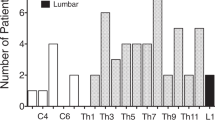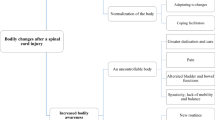Abstract
This investigation was concerned with the personality characteristics of a sample of patients with spinal cord lesions. One group of paraplegic patients was compared wth a group of quadriplegic patients. The paraplegics manifested certain characteristics indicating childlike immediate needs for gratification, together with difficulties in interpersonal relationships. The quadriplegic appears to be more absorbed with his disability, and evidences a great deal of concern about the human body. It appears worth while, therefore, in reporting on patients with spinal cord lesions, that distinction be made between the various neurological disabilities.
Similar content being viewed by others
Log in or create a free account to read this content
Gain free access to this article, as well as selected content from this journal and more on nature.com
or
References
Berger, S (1952). In Paraplegia in Psychological Aspects of Physical Disability, edited by J. F. Garrett. Washington: Office of Vocational Rehabilitation.
Klopfer, B, Ainsworth, M D, Klopfer, W B & Holt, R R (1954). Development in the Rorschach Technique. Vol. 1: Technique and Theory. New York: World Book Co.
Mosak, H H (1948). Personality Adjustment of Paraplegic Veterans. Hines, Ill.: Hines Paraplegic Center.
Mosak, H H (1951). J. cons. Psychol. 15, 346.
Mueller, A D (1950). J. cons. Psychol. 14, 189.
Mueller, A D (1962). Arch. Neurol. 7, 355.
Author information
Authors and Affiliations
Rights and permissions
About this article
Cite this article
Hirschenfang, S., Benton, J. Rorschach responses of paraplegic and quadriplegic patients. Spinal Cord 4, 40–42 (1966). https://doi.org/10.1038/sc.1966.4
Issue date:
DOI: https://doi.org/10.1038/sc.1966.4



